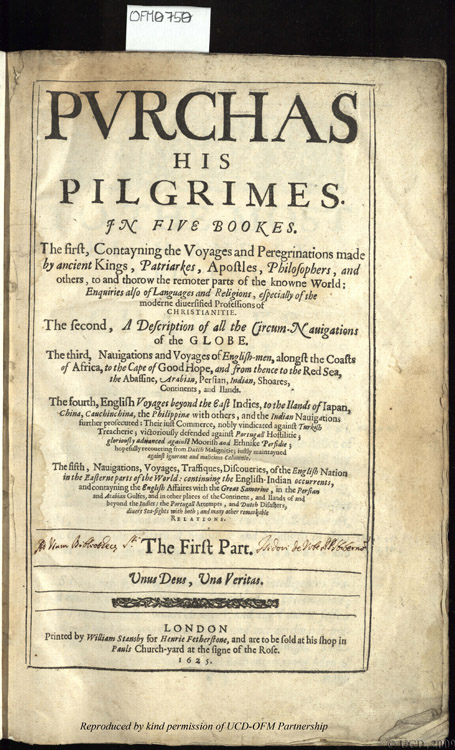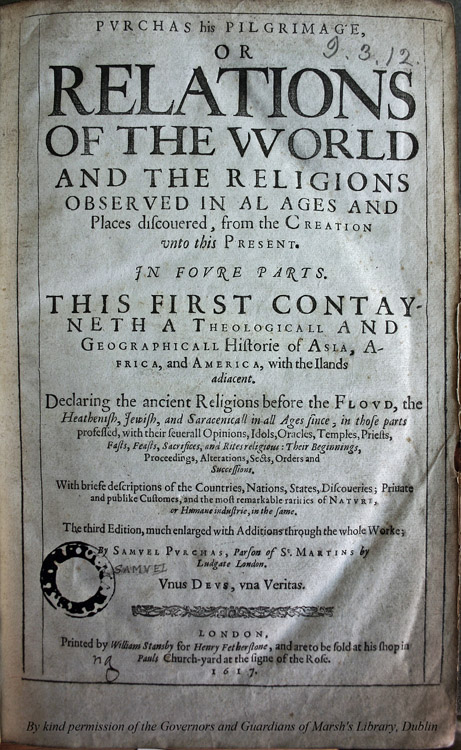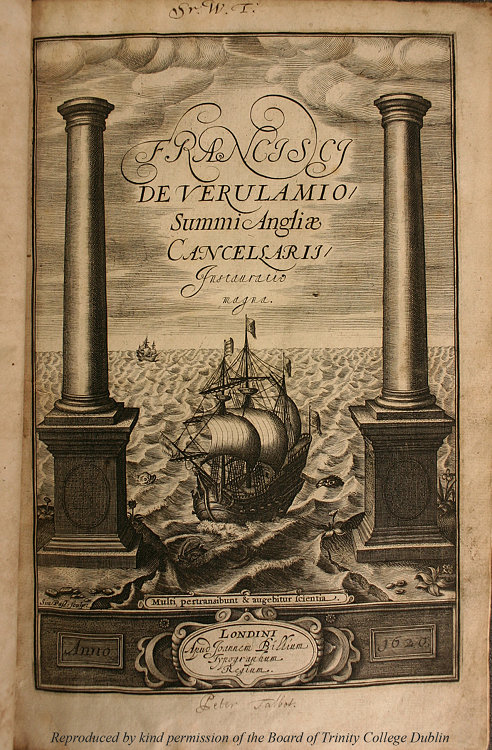Hakluytus Posthumus, or Purchas his Pilgrimes, Contayning a History of the World, in Sea Voyages, & Lande Travels, by Englishmen and others
by Dr James Robert Wood, Trinity College Dublin

Samuel Purchas' Hakluytus Posthumus, or Purchas his Pilgrimes, Contayning a History of the World, in Sea Voyages, & Lande Travels, by Englishmen and others (1625) is a massive compendium of travel narratives, most of them concerning the journeys of English travelers in the Elizabethan and Jacobean periods. At the time it was the largest work in English ever published. In its original edition, Purchas' work was divided into four folio volumes. The structure of the work is haphazard but its general movement is from regions proximate to Europe to more distant lands. The first and second volumes are largely taken up with travels in Africa, the Near East, and the East Indies. The third volume encompasses travels to the Far East of China and Japan and the extreme North of Russia, Greenland, Iceland, and the Artic, with accounts of early attempts to find the Northwest Passage. The fourth volume is devoted to the New World of the Americas and the West Indies.
Although he collected accounts of travels over the entirety of the known world, Purchas himself never set foot outside England. In Purchas his Pilgrimes, he tells us that he has never been "200 miles from Thaxted in Essex where I was borne." Purchas was the sixth son of George Purchas, a cloth trader, and was baptized in Thaxted in 1577. He attended Cambridge University and was ordained as a Deacon in 1598 and a Priest in 1601. He worked in various posts as a clergyman in the Church of England in Essex and in London. At the same time, he was researching and writing the books for which he would become famous: Purchas, his Pilgrimage or Relations of the World and the Religions Observed in all Ages and Places Discovered from the Creation to the Present, (1613), Purchas his Pilgrim, or Microcosmos, of the History of Man (1619), and finally Purchas his Pilgrimes, published a year before Purchas' death in 1626.

As the titles to his books suggest, Purchas saw his works as intertwined with one another. They attempt to reconcile outward ventures into the world with the inward pilgrimage of the soul. Purchas, his Pilgrimage surveys the world's regions, peoples, and religions, frequently drawing on accounts of voyages and travels around the world. Purchas his Pilgrim turns from the global focus of Purchas, his Pilgrimage to interrogate the individual soul. Purchas his Pilgrimes moves outward into the world again, presenting redacted versions of the oral and written travel narratives Purchas had been collecting over the course of twenty years. In the first volume of Purchas his Pilgrimes, Purchas describes the relationship between the Pilgrimes and his earlier work Purchas, his Pilgrimage as follows:
"These bretheren, holding much resemblance in name, nature and feature, yet differ in both the object and the subject. This [the Pilgrimage] being mine own in matter, though borrowed, and in form of words and method; whereas my Pilgrimes are the authors themselves, acting their own parts in their own words, only furnished by me with such necessities as that stage further required, and ordered according to my rules."
The alternate title for Purchas' work, Hakluytus Posthumus, also announces the work's status as a sequel to Richard Hakluyt's similarly vast compendium of travel narratives entitled The Principal Navigations Voyages Traffiques & Discoveries of the English Nation (1589). Purchas worked for a time as Hakluyt's assistant and he acquired the unpublished manuscripts for The Principal Navigations after Hakluyt's death in 1616. He drew upon them extensively in Purchas his Pilgrimes.
In addition to Hakluyt, Purchas cultivated contacts with the organizations central to England's mercantile and colonial expansion while compiling his materials. He joined the Virginia Company, created for the purpose of promoting the settlement of North America, in 1622. Purchas wrote Purchas his Pilgrimes under the patronage of the East India Company. The Company awarded Purchas 100 pounds to assemble the book and gave him access to many of the letters and manuscripts that Purchas would draw on in writing his magnum opus. Purchas' work paints a heroic portrait of England's redoubtable traders, who suffer many battles at sea, incarcerations, illnesses, and other misfortunes. It frequently dwells on what Purchas refers to as the "treacheries" of the Portuguese, Spanish, and Dutch merchants with whom they competed, not to mention the many "treacheries" of the peoples whom they encountered, traded with, and sometimes helped colonize. In the interstices of their narratives, however, Purchas' pilgrims provide rich geographical and ethnographic descriptions of the lands and peoples they saw, colored of course by their own cultural and religious assumptions.
Purchas' work combines pro-mercantilism with a virulent anti-Catholicism. As David Armitage notes in The Ideological Origins of the British Empire, Purchas worked on Purchas his Pilgrims under the auspices of King James I's College of Divinity at Chelsea, "led by the militant former dean of Exeter, Matthew Sutcliffe, and the very arsenal of anti-Catholic polemic during James's reign." Purchas includes a long editorial disparaging the crusades and the Catholic pilgrimages to the Holy Land. He remarks that many of these pilgrims "travelled nothing from themselves and their vices in this Pilgrimage, as the stories testifie: yea Vitraicus Bishop of Achon, tells of the Christians which lived at Jerusalem, as if they were the worst in all the world." The collection aims to create an ideal of a Protestant and mercantile pilgrimage to replace its Catholic and devotional precursor.
Purchas does include travelers who described themselves as actual "pilgrims." But even in their narratives the line between spiritual and material acquisition is often blurred. For example Henry Timberlake's narrative, excerpted by Purchas, describes the Protestant Timberlake's imprisonment in Jerusalem for his refusal "to deny my Countrey nor Religion," his eventual release, and his visits to the holy sites. Timberlake was not, however, a purely religious traveler; he was also a merchant in the Levant trade. Purchas' pilgrims frequently travel to the Near East explicitly in the pursuit of profit. Purchas includes a narrative of the voyage of Sir Henry Middleton in the appropriately named Trade's Increase in the Red Sea, and recounts the story of how Middleton was made a captive for six months by Turks in Mocha. But the motives of Purchas' merchants in traveling through the Near East are frequently mixed. Purchas includes a redacted account of the travels of John Sanderson, a Levant Company merchant, from Constantinople, to locations in North Africa and the Near East. Sanderson's travels are presented, though, as "Personal Voyages," made primarily in order to see new places. The pursuit of trade, knowledge, and spiritual renewal blend together in surprising combinations in Purchas his Pilgrimes. In his commentary on the narratives, Purchas does his best to represent all three as different aspects of the same thing.
Purchas associates economic with spiritual enrichment by prefacing his work with a long discussion of King Solomon's mercantile activities as related in the Bible's Book of Kings. The first of Purchas' "Pilgrimes" are the navigators who left the ancient Red Sea port of Ezion-Geber to Ophir and returned to King Solomon with ships laden with gold and goods. By Purchas' time, extant identifications of Ophir's locality were bound only by the map of the known world: they ranged from Japan (Marco Polo) to Peru (Benito Arias Montano). The geographical indeterminacy of Ophir helps make it a floating signifier for the world outside Europe for Purchas. King Solomon's navigators are the model for Purchas' mercantile pilgrims, who venture out to bring the treasures of the world back to England. Similarly, Solomon becomes Purchas' model for himself as a compiler of travel narratives. Like Solomon, Purchas stays at home and allows his envoys to bring their "Ophir materials" back to him.
Purchas, then, sees travel and trade as bringing intellectual improvements along with spiritual and economic benefits. He suggests that Solomon found in the treasures of Ophir "new experiments in Minerals, Gems, Beasts, Fowles, Fishes, Serpents, Wormes, Trees, Fruits, Gums, Plants, Men; Climates, Winds, Seasons, Seas, Lands, Soyles, Rivers, Fountaynes, Heavens, and Stars; and a World of the Worlds varieties..." Purchas did receive 100 pounds from the East India Company for his work. But he represents the chief fruits of his work as the enrichment of knowledge through what he calls, in the dedicatory epistle to Prince Charles, his "new method of eye-evidence." Many scholars have noted the resemblances of Purchas' description of his project to Sir Francis Bacon's proposals for reestablishing knowledge on the principles of observation and experiment. Bacon's Essays contains a piece entitled "Of Travel" and in his writings promoting empirical methods in the human and natural sciences Bacon identified the writings of travelers as an important resource of the new knowledge that would replace the outdated systems of the ancients. The frontispiece to his Instauratio Magna (1620) depicts a ship sailing out of the Pillars of Hercules, which were supposed to straddle the Strait of Gibraltar. Purchas' book, published just five years later, literalizes Bacon's metaphor for the progress of knowledge into uncharted territory.

If, in Purchas' vision, Protestantism and trade go together, then so too do seafaring and knowledge. Purchas claims his own moment as a time of rebirth not only of learning but also of navigation, "which had been buried together in the same Grave with the Roman Greatnesses, and now are as it were raysed againe from the dead." Learning and navigation are "Twinnes" and both expand in tandem with one another. For Purchas, the peoples of the East's supposed deficiencies in both learning and navigation are the signs of a pervasive intellectual myopia:
"The Persian, the Mogoll, the Abassine, the Chinois, the Tartarian, the Turke, are called Great, but their greatnesses is like Polyphemus with one eye, they see at home like purblind men neere to them, not farre off with those eyes of Heaven, and lights of the World, the Learned knowledge whereof is requisite to Navigation."
In editorial comments like these we can find the beginnings of the idea of a backward and unchanging East that Edward Said anatomizes in Orientalism. But Purchas' pilgrims' own narratives do not necessarily fit this ideological mould. Their descriptions of Near East societies do not adopt a uniform posture of superiority in relation to non-Europeans. And although the vast majority of Purchas' pilgrims are English, Purchas his Pilgrimes includes a few writings by non-European commentators on the Near East. He incorporates some "Collections of Asia, especially of Arabia, gathered out of an Arabicke book of Geographie, written by a Nubian, foure hundred and seventie yeeres ago." This chapter was based on a selection of the Moroccan geographer Muhammad al-Idrisi's Nuzhat al-mushtäq, which was translated into Latin by Gabriel Sionita and John Hesronita in 1619 under the title Geographia Nubiensis. Al-Idrisi was not, of course, a "Nubian." Nevertheless other voices besides those of the English travelers do find their way into Purchas his Pilgrimes, however garbled they might be in translation.
Purchas his Pilgrimes is a trove of information on English activities in the Near East and it shows how English perceptions of Ottomans and Persians were developing in the Early Modern period. Purchas' framing of the narratives provided an important articulation and ideological justification of England's mercantile and imperial ambitions in the seventeenth century. The work is a central document for all researchers interested in England's relations with the Near East. In Dublin, copies of the first edition of Purchas his Pilgrimes are held in Trinity College Dublin Library, University College Dublin Library, and Marsh's Library.
To see the catalogue entry for Purchas his Pilgrimes click here.
Bibliography:
- Armitage, David. "Purchas, Samuel (bap. 1577, d. 1626)." Oxford Dictionary of National Biography. Oxford: Oxford University Press, 2004 [accessed 10 September 2012: http://www.oxforddnb.com/view/article/22898]
- Armitage, David. The Ideological Origins of the English Empire. Cambridge: Cambridge University Press, 2000.
- Adams, Percy G. Travel Literature and the Evolution of the Novel. Lexington: University of Kentucky Press, 1983.
- Edwards, Philip. Pilgrimage and Literary Tradition. Cambridge: Cambridge University Press, 2005.
- Fuller, Mary C. Remembering the Early Modern Voyage: English Narratives in the Age of European Expansion. New York: Palgrave Macmillan, 2008.
- Hay, Denys. Europe: The Emergence of an Idea. Edinburgh: Edinburgh University Press, 1952.
- Jannet, Linda. "Purchas his Pruning: Refashioning the Ottomans in Seventeenth-Century Travel Narratives." Huntington Library Quarterly 74 (2011): 219-42.
- Lawson, Phillip. The East India Company: A History. London: Longman, 1993.
- Pennington, Loren E. “Hakluytus Posthumus: Samuel Purchas and the Promotion of English Overseas Expansion.” Emporia State Research Studies 14 (1966): 11.
- Pennington, Loren E. Ed. The Purchas Handbook: Studies of the Life, Times and Writings of Samuel Purchas 1577-1626 With Bibliographies of his Books and of Works about Him. 2 Vols. London: The Hakluyt Society, 1997.
- Steele, C.R. "From Hakluyt to Purchas." The Hakluyt Handbook. Ed. D.B. Quinn. 2 Vols. London: Hakluyt Society, 1974.